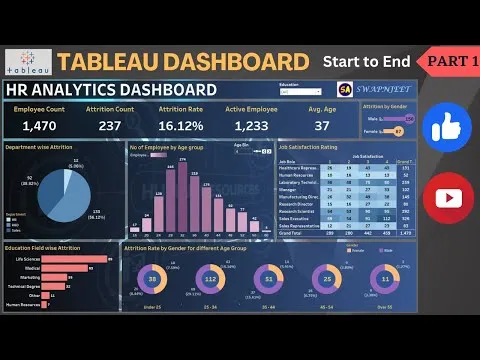
Data Visualization using Tableau 
Tableau is a powerful data visualization tool that can help users of all levels, from beginner to intermediate, to create meaningful visualizations of their data. With Tableau Fundamental, users can learn the basics of Tableau and start creating their own data visualizations. ▼
ADVERTISEMENT
Course Feature
![]() Cost:
Cost:
Free
![]() Provider:
Provider:
Udemy
![]() Certificate:
Certificate:
Paid Certification
![]() Language:
Language:
English
![]() Start Date:
Start Date:
On-Demand
Course Overview
❗The content presented here is sourced directly from Udemy platform. For comprehensive course details, including enrollment information, simply click on the 'Go to class' link on our website.
Updated in [February 21st, 2023]
Learners can learn the fundamentals of data visualization and Tableau, including the application terminology, connecting to data, editing data connections and data sources, joins in Tableau, data source level filters, connecting to Oracle, SQL Server, Google Analytics, different RDBMS databases, connecting to big databases like HDFS, Hive, Greenplum, Teradata, calling stored procedures in Tableau, join types, custom SQLs, elements of visualization, understanding of dimensions and measures, basic and dual axis graphs, data filtering, data blending and joins, connection types, dashboard creation, sharing work, dashboard best practices, story telling, and publishing data. They can also learn how to move from simple to complex visualizations and combine them in interactive dashboards.
[Applications]
Upon completion of this course, participants will have a better understanding of the fundamentals of Tableau and be able to apply the concepts to create interactive visualizations and dashboards. They will be able to connect to different data sources, create basic and complex visualizations, and share their work with others. Participants will also be able to use best practices for dashboard creation and storytelling.
[Career Paths]
Job Position Paths:
1. Data Visualization Analyst: Data Visualization Analysts are responsible for creating visual representations of data to help organizations make better decisions. They use Tableau to create interactive dashboards, charts, and graphs to help organizations understand their data. They also develop data models and algorithms to help organizations better understand their data. As the demand for data-driven decision making increases, the demand for Data Visualization Analysts is expected to grow.
2. Business Intelligence Developer: Business Intelligence Developers use Tableau to create interactive dashboards and reports to help organizations make better decisions. They develop data models and algorithms to help organizations better understand their data. They also develop data visualizations to help organizations better understand their data. As the demand for data-driven decision making increases, the demand for Business Intelligence Developers is expected to grow.
3. Data Scientist: Data Scientists use Tableau to analyze large datasets and develop predictive models to help organizations make better decisions. They use Tableau to create interactive dashboards and reports to help organizations better understand their data. They also develop data visualizations to help organizations better understand their data. As the demand for data-driven decision making increases, the demand for Data Scientists is expected to grow.
4. Data Analyst: Data Analysts use Tableau to analyze large datasets and develop insights to help organizations make better decisions. They use Tableau to create interactive dashboards and reports to help organizations better understand their data. They also develop data visualizations to help organizations better understand their data. As the demand for data-driven decision making increases, the demand for Data Analysts is expected to grow.
[Education Paths]
1. Bachelor of Science in Data Science: This degree program focuses on the development of data-driven solutions to real-world problems. It combines the principles of mathematics, computer science, and statistics to analyze and interpret data. Students learn to use data visualization tools such as Tableau to create meaningful visualizations of data. This degree is becoming increasingly popular as businesses and organizations rely more heavily on data-driven decision making.
2. Master of Science in Business Analytics: This degree program focuses on the application of data analytics to business problems. Students learn to use data visualization tools such as Tableau to create meaningful visualizations of data. They also learn to use predictive analytics to identify trends and patterns in data. This degree is becoming increasingly popular as businesses and organizations rely more heavily on data-driven decision making.
3. Master of Science in Data Science: This degree program focuses on the development of data-driven solutions to real-world problems. It combines the principles of mathematics, computer science, and statistics to analyze and interpret data. Students learn to use data visualization tools such as Tableau to create meaningful visualizations of data. This degree is becoming increasingly popular as businesses and organizations rely more heavily on data-driven decision making.
4. Doctor of Philosophy in Data Science: This degree program focuses on the development of data-driven solutions to real-world problems. It combines the principles of mathematics, computer science, and statistics to analyze and interpret data. Students learn to use data visualization tools such as Tableau to create meaningful visualizations of data. This degree is becoming increasingly popular as businesses and organizations rely more heavily on data-driven decision making.
Pros & Cons

Good for intermediate course student

Very informative

Teaching is crystal clear

Bueno

Not suitable for beginners

No file provided to follow along
Course Provider

Provider Udemy's Stats at AZClass
Discussion and Reviews
0.0 (Based on 0 reviews)
Explore Similar Online Courses

Essay Essentials: Improve Your Academic Writing

Object Detection 101 Course - Including 4xProjects Computer Vision

Python for Informatics: Exploring Information

Social Network Analysis

Introduction to Systematic Review and Meta-Analysis

The Analytics Edge

DCO042 - Python For Informatics

Causal Diagrams: Draw Your Assumptions Before Your Conclusions

Whole genome sequencing of bacterial genomes - tools and applications

Tableau Dashboard from Start to End (Part 1) HR Dashboard Beginner to Pro Tableau Project

Tableau 10 for Data Scientists


Start your review of Data Visualization using Tableau